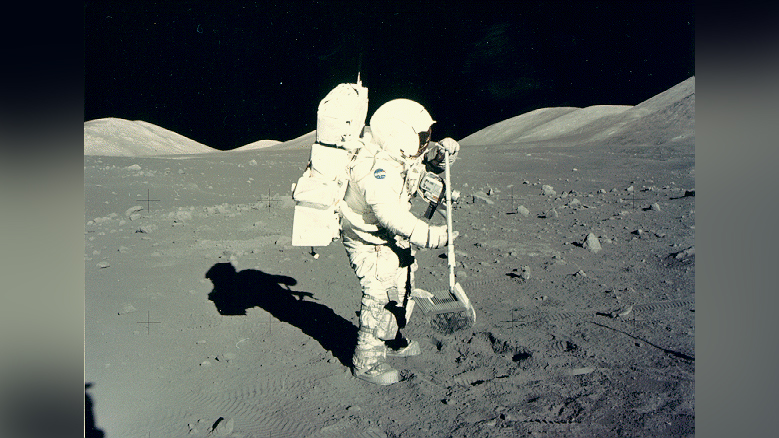Mysteriously magnetic rocks collected on Apollo mission finally get an explanation
The rocks retrieved by the Apollo missions have puzzled scientists for 50 years.

Scientists may have finally come up with an explanation for one of the Apollo program's most enduring mysteries: why some of the rocks brought back from the lunar surface appear to have been formed inside a magnetic field as strong as that on Earth.
Magnetic fields are produced inside planetary bodies by the churning movement of material in planets’ electrically conductive molten cores. But today the interior of the non-magnetic moon is quite different from Earth's magnetized innards — it's dense and mostly frozen, containing only a small outer core region that is fluid and molten. Scientists believe that the moon's insides cooled fairly quickly and evenly after it formed around 4.5 billion years ago, meaning it doesn't have a strong magnetic field — and many scientists believe it never did.
How then, could some of the 3 billion-year-old rocks retrieved during NASA's 1968-to-1972 Apollo missions look like they were made inside a geomagnetic field powerful enough to rival Earth's, while others had barely any magnetic signatures at all?
Related: 5 strange, cool things we've recently learned About the moon
"Everything that we've thought about how magnetic fields are generated by planetary cores tells us that a body of the moon's size should not be able to generate a field that's as strong as Earth's," Alexander Evans, a planetary scientist at Brown University, said in a statement.
Scientists have come up with a raft of potential explanations over the last 50 years for this weird discrepancy. Perhaps, after its formation, the moon didn't freeze over as fast as first thought; or maybe the moon's gravitational interaction with Earth gave it an exaggerated wobble, sloshing around its cooling insides to boost its magnetic field. Another idea is that asteroids bombarded the moon so much, the jolts kickstarted the lunar core into fitful activity.
Now, Evans and his co-author Sonia Tikoo-Schantz, a geophysicist at Stanford University, have come up with a brand new explanation, published Jan. 13 in the journal Nature Astronomy.
Sign up for the Live Science daily newsletter now
Get the world’s most fascinating discoveries delivered straight to your inbox.
"Instead of thinking about how to power a strong magnetic field continuously over billions of years, maybe there's a way to get a high-intensity field intermittently," Evans said.
During the first few billion years of the moon's life, long before most of it froze inside to leave only a small iron inner core surrounded by a partially molten outer core, our orbital companion was an ocean of molten rock. Importantly, however, the moon's core wasn't significantly hotter than the mantle above it, meaning that very little convection between the two occurred. The fact that the moon’s molten contents couldn’t churn inside it meant that it couldn't have had a steady magnetic field like Earth's.
But the researchers say the moon could have created a strong intermittent field. As the moon cooled over time, the minerals contained inside its hot magma would have cooled at different rates. The densest of the minerals — olivine and pyroxene — would have chilled and sunk first, and the less dense magma, containing titanium alongside heat-producing elements like potassium, thorium and uranium, would have risen to just beneath the crust and lost their heat later on. After cooling to the point of crystallization, the titanium-loaded rock would be heavier than many of the solids below it, causing it to sink slowly but inexorably toward the molten outer core.
By studying the known composition of the moon and making a calculated guess on its past mantle viscosity — or how easily its magma could churn — the scientists estimated that the moon's sinking titanium would have broken into chunks as small as 37 miles (60 kilometers) across and sunk at various rates over the course of roughly a billion years. Each time one of these cold titanium chunks hit the moon's hot outer core, the temperature difference would have reignited the core's dormant convection currents, briefly jump-starting the moon's magnetic field.
"You can think of it a little bit like a drop of water hitting a hot skillet," Evans said. "You have something really cold that touches the core, and suddenly a lot of heat can flux out. That causes churning in the core to increase, which gives you these intermittently strong magnetic fields."
If the moon's magnetosphere really was this inconstant, these brief bursts of magnetism would be enough to explain why different rocks found on the moon carry different magnetic signatures.
Next, the scientists say they will test Apollo's lunar rocks to see if this pattern — a weak magnetic hum occasionally interrupted by a gigantic field — can be found. If bursts of strong magnetic signatures are found among weak magnetic signatures, it could put the mystery of the moon's magnetism to bed once and for all.
Originally published on Live Science.

Ben Turner is a U.K. based staff writer at Live Science. He covers physics and astronomy, among other topics like tech and climate change. He graduated from University College London with a degree in particle physics before training as a journalist. When he's not writing, Ben enjoys reading literature, playing the guitar and embarrassing himself with chess.










